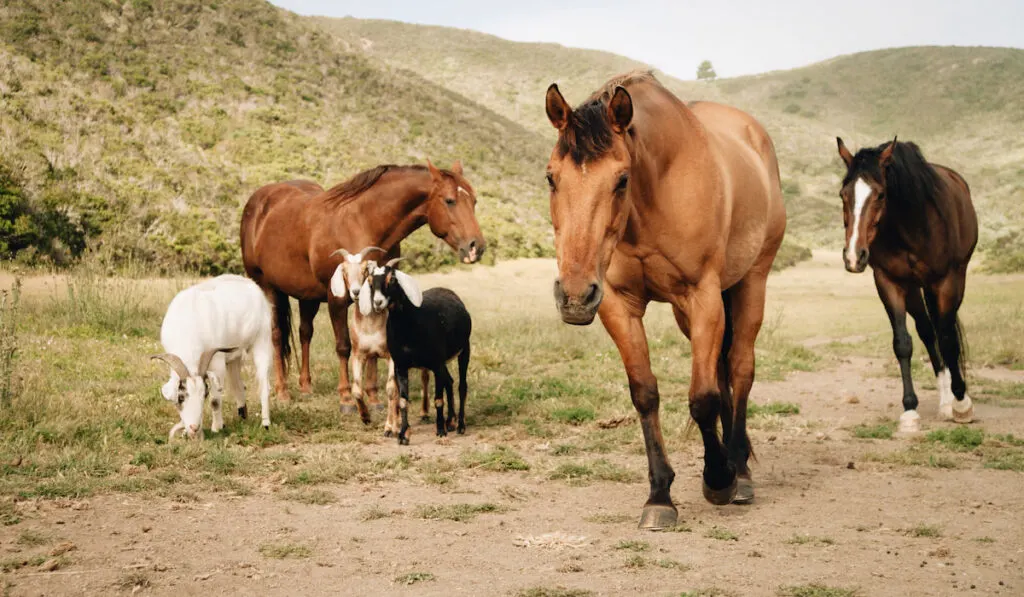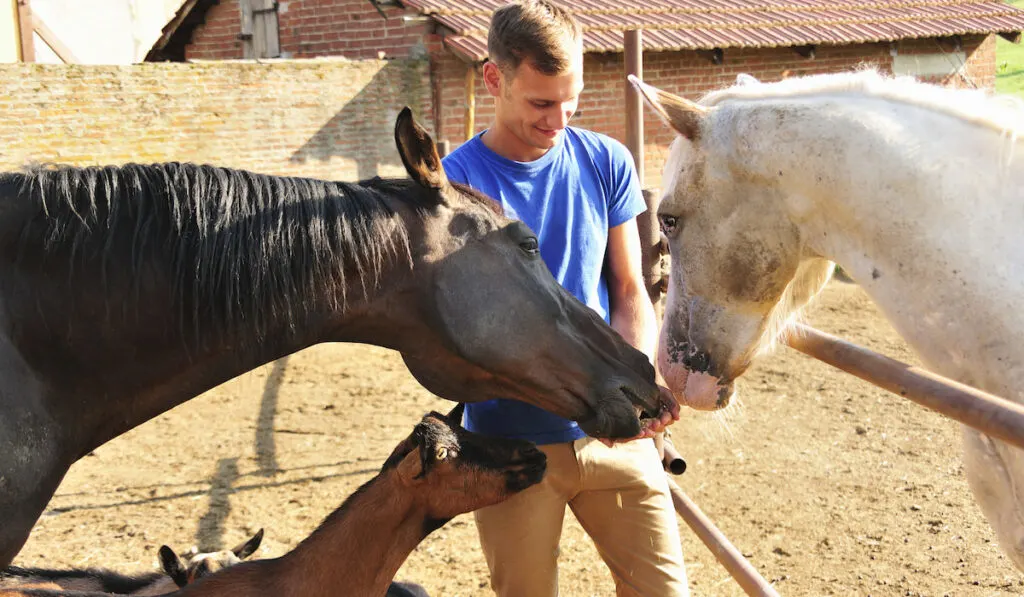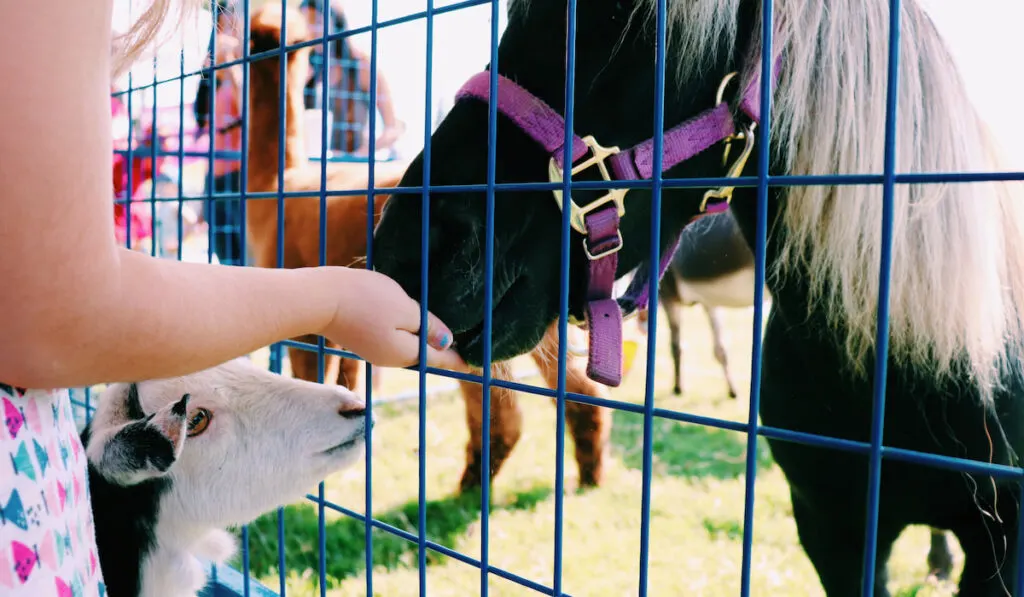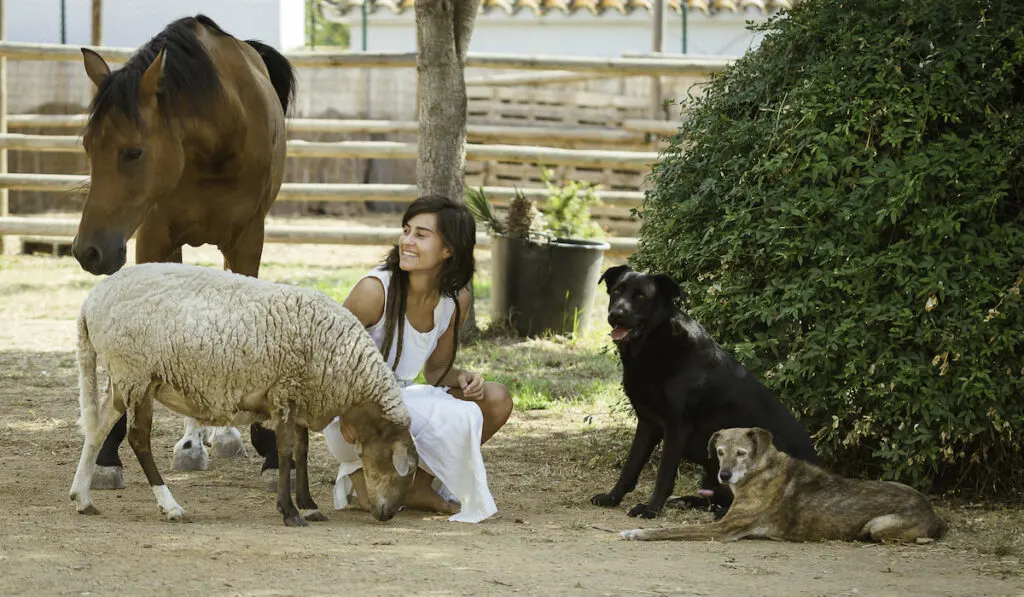If you own a stable and keep horses in it, you might be wondering whether you can keep other animals in the same stable. If you aren’t interested in adding another horse to the mix, what other options are there? Goats are smaller than horses and could certainly fill in the space, but are they a good fit?
Can goats and horses live together?
Not only is it safe for goats and horses to live together, but goats also make excellent companions for horses. Both animals can graze on the same land and are adapted to moving in herds, so they are often quite compatible and quickly take to one another.

Table of Contents
Do Horses and Goats Get Along?
Horses get along very well with goats. Most horses are comfortable sharing outdoors with other animals including goats. However, you will have to supervise them especially at the early stages.
Horses and goats are both social herd animals that enjoy being around other animals. Both species can be easy going and naturally find themselves getting along with one another.
Of course, each animal is unique and will have its own disposition. You should make sure to understand how your animals behave before bringing them together.
Horses can be hostile or friendly, and a horse’s temperament is partly dependent on its circumstances. Always be on the lookout when you have mixed species living together.
Benefits of Raising Goats and Horses Together
Horses are social animals that love to live in groups with other horses but also other animals including goats. Horses and goats are both quite intelligent, and they can quickly form a connection when brought together.
Goats and horses are hard to manage when they are isolated. When lonely, they experience anxiety or stress.
When a horse is nervous, it walks or runs within its stall. But with a companion or two, they are less likely to experience these symptoms and become more calmer and more agreeable with humans.
The companionship between both animals is quite significant. There’s even a practice where a horse’s goat friend is brought in to conciliate the horse just before a race.

Why Goats and Horses Are Paired Together
Grazing
Although goats and horses are herbivores, they do not compete for food. Goats feed on weeds, branches of trees, and bushes. Horses commonly feed on grasses and legumes.
When the goats are done feeding, they create space for the grasses and legumes that the horses feed on.
Companionship
Goats serve as traveling companions for horses. Horses are happier and less nervous when they have another animal to interact with or distract them. Goats are a more economical way to provide your horse with company, either in the stable, on the farm, or on the road compared with bringing on another horse or a pony.
Entertainment
Goats are active, social, and fun animals that bring entertainment to the stable or farm for their owners.
Goats love to climb. They climb inanimate objects like fences, but they also climb on other animals including their horse friends. Watching a goat climb on a horse can be very entertaining.

Best Type of Goat for Horse Companions
Before you bring in a goat to befriend your horse, you need to make sure you have the right type of goat in mind.
There are several factors to consider before getting a goat for your horse. These include the gender, size, and breed of the goat.
Gender
If you are getting a goat as a horse’s companion, consider selecting a female goat.
Female goats are calmer and less likely to excite your horse than their male counterparts. In fact, male goats, even if castrated, can be quite aggressive to horses.
Size
A full-size or full-grown goat is a better choice for a horse companion. They can live safely with horses compared to younger goats or smaller goat breeds like Kinder and Pygmy.
Smaller goats can be at risk for getting stepped on, causing harm to both the horse and the goat.
Breed
The best full-size goat breeds for horse companionship are the Boer, Saanen, or Nubian.
Horned goats are not ideal to live with horses. Horned goats are considerably aggressive, and their horns can be harmful.
You should also avoid fainting goats. These goats often falling over, and if they fall down around a horse, they could get stomped on and injured.
What You Should Know Before Introducing Your Goat to Your Horse
Before you introduce your goat into the horse’s safe space, you have to take note of certain things to ensure the meeting and pairing are a success.
These considerations are even more important if the horse has never seen a goat before or if you are new to raising the animals together.
Here are some things you should know before you put your goat and horse together:
- Be careful if this is your horse’s first time near a goat. You will need to be cautious when introducing them so neither animal gets scared, over excited, or injured.
- Commercial horse feeds are toxic to goats. Do not mix their feed.
- Build high, strong fences that goats cannot escape from. Remember, goats love climbing, and they are good at it. Choose woven wire fencing and make sure your fence is tall enough to prevent escape.
- Choose a calm goat that cannot accidentally injure your horse. Consider a goat without horns and preferably a female.

7 Tips for Safely Introducing Your Goat to Your Horse
The hardest part of keeping a goat and a horse together in the same space is the introductory phase. The process can be similar to the process of introducing two horse to one another.
Here are 7 tips to safely introduce your goat to your horse:
- Restrain the horse with a lead rope or keep it in a round pen while you bring the goat around. This helps ensure that the introduction is steady.
- Keep a reasonable distance between the horse and the goat.
- Gradually bring them closer to each other but slow down or separate them if either animal shows signs of disagreement.
- Bring the goat close enough for the horse to bend and smell. Keep the goat far enough away that the horse cannot reach and bite it.
- Feed the goat and horse near each other in a well-controlled environment.
- Watch how the horse and goat regard one another, especially during feeding, to confirm that they are getting along well.
- When you feel comfortable, turn the horse and goat out together to interact. Be watchful at first to ensure the safety of both animals.
Final Thoughts
Goats are great companions for horses, and the two animal species can live together harmoniously. If you are planning to keep a goat with a horse, be sure to monitor their initial interactions until it is clearly safe to leave them unsupervised.
Resources
- https://chicagotribune.com/news/ct-xpm-1996-08-01-9608010109-story,amp.html
- https://helpfulhorsehints.com/goats-and-horses-togther/
- https://opensanctuary.org/article/how-horses-get-along-with-other-species/
- https://proequinegrooms.com/tips/barn-management/goats-and-horse-go-together-like-pb-and-j
- https://equinehelper.com/do-horses-get-along-with-goats/
